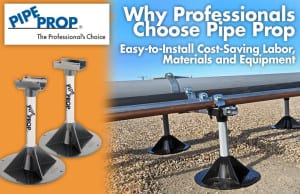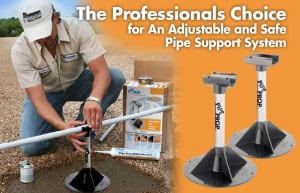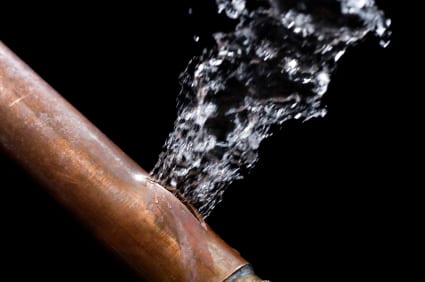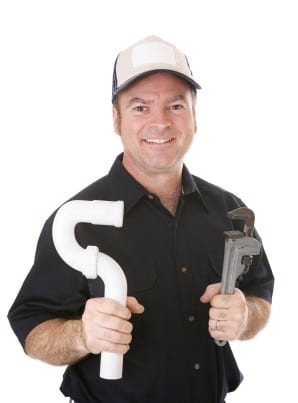 Leading the industry and the choice of professional contractors across the nation, the Pipe Prop adjustable pipe support system provides the best overall pipe stand product on the market today. From roofing contractors, plumbers and HVAC installers, the durability, cost-effectiveness and easy-to-adjust system provides flexibility for practically every situation is what professionals rely on day-in and day-out.
Leading the industry and the choice of professional contractors across the nation, the Pipe Prop adjustable pipe support system provides the best overall pipe stand product on the market today. From roofing contractors, plumbers and HVAC installers, the durability, cost-effectiveness and easy-to-adjust system provides flexibility for practically every situation is what professionals rely on day-in and day-out.
Pipe Prop – Tested and Proven from Coast-to-Coast
 From California to Florida, the Pipe Prop adjustable support system has been tested and proven among some of the most severe weather conditions throughout the United States. And with more than 170 distributors across the United States, the Pipe Prop adjustable pipe system is easily purchase and is most likely at a location near you. Take a look to the to the right side of our web site for a state and city that is closest to you for your next order.
From California to Florida, the Pipe Prop adjustable support system has been tested and proven among some of the most severe weather conditions throughout the United States. And with more than 170 distributors across the United States, the Pipe Prop adjustable pipe system is easily purchase and is most likely at a location near you. Take a look to the to the right side of our web site for a state and city that is closest to you for your next order.
The Right Pipe Support for the Right Industry
 Industry professionals throughout the United States trust and incorporate the Pipe Prop adjustable pipe support system for securing industrial pipe on top of commercial buildings and structures whether supporting electrical systems, gas supply lines or HVAC drainage for safer and reliable work environment
Industry professionals throughout the United States trust and incorporate the Pipe Prop adjustable pipe support system for securing industrial pipe on top of commercial buildings and structures whether supporting electrical systems, gas supply lines or HVAC drainage for safer and reliable work environment
How Plastic Compression Fittings Work
 Plumbing support system
Plumbing support system
Mainly to be found on the larger plastic pipework (think drainage), the plastic compression fittings work in the same way as the older style metal compression fittings which although still in use today, the end feed, soldered fittings are a quicker and more reliable way to connect your pipework.
Why Compression?
The ability to unscrew and remove the fitting with ease makes it ideal for areas where it may be necessary to occasionally strip down; waste pipes are the prime example – particularly where there is a water trap fitted to the bottom of a basin or tub. It means that you can easily access the trap for removal and cleaning.
Compressing?
As the name implies, the watertight seal of the fitting is reliant on the compression of a rubber ‘washer’.
It is usually shaped as a near conical, allowing for a better seal with less force applied. As the ‘nut’ tightens up against the fitting, it squeezes the seal into a chamfered area on the fitting, the angle of which matches the conical shape of the seal.
Leaks
It is still possible to get leaks with these types of fittings, but in our experience, that is usually an error on the part of the fitter; over-tightening the fitting can squash and deform the seal, under-tightening means that the seal isn’t mated to the fitting properly. Both of these are common mistakes, fortunately, quite easily remedied.
When using these fittings, ensure that the pipe is cleanly and squarely cut, be sure to remove all the burrs on the edge of the pipe; it is always preferable to chamfer the edge slightly.
Whatever plumbing that you’re doing, remember to support the pipework properly and correctly. Chances of failure with any type of pipework are greatly reduced once they are supported.
For all of your pipe support needs, talk to Pipe Prop at 1-888-590-0120
Common Plumbing Problems
 As homeowners, many of us take on the challenge of becoming the world’s best handyman (or woman!), taking on the problems that just seem to be part of owning property. Fixing the odd crack here and there, putting up a picture is all quite easy, but when it comes to plumbing, there is a lot more at stake – any problems could potentially lead to disaster! Water can have devastating consequences to a home.
As homeowners, many of us take on the challenge of becoming the world’s best handyman (or woman!), taking on the problems that just seem to be part of owning property. Fixing the odd crack here and there, putting up a picture is all quite easy, but when it comes to plumbing, there is a lot more at stake – any problems could potentially lead to disaster! Water can have devastating consequences to a home.
Basics
A leaky faucet is perhaps one of the most common problems that you are likely to encounter, although with today’s modern ceramic faucets, that is fast becoming a thing of the past. With the older style faucets though, many people try a little extra pressure when turning them off, believing that it will stop that annoying drip-drip-drip. However, increasing the pressure used to turn them off will only make the leak worse – compressing the rubber washer to the point of failure.

 Plumbing support system
Plumbing support system